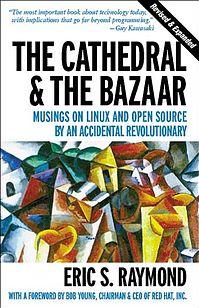 |
| Cover picture from Wikipedia |
Author
Eric Steven Raymond, American computer programmer, author and open source software advocate.Summary
The essay contrasts two different software development models: the Cathedral model, in which source code is available with each software release, but code developed between releases is restricted to an exclusive group of software developers; and the Bazaar model, in which the code is developed over the Internet in view of the public.
The essay's central thesis is Raymond's proposition that "given enough eyeballs, all bugs are shallow" (which he terms Linus's Law): the more widely available the source code is for public testing, scrutiny, and experimentation, the more rapidly all forms of bugs will be discovered. (source: Wikipedia)
The essay's central thesis is Raymond's proposition that "given enough eyeballs, all bugs are shallow" (which he terms Linus's Law): the more widely available the source code is for public testing, scrutiny, and experimentation, the more rapidly all forms of bugs will be discovered. (source: Wikipedia)
Status
While I was doing a summer course at the Baylor University in Waco, Texas, back in 2002, I bought this book in the campus bookshop and read it during my flight back to Europe.
I enjoyed the technical aspects, but was especially intrigued by the essay "Homesteading the Noosphere" (1) which gave me a glance at the psyche of an open source developer and how the behaviour can be explained by the habits of a "gift culture".
I have no idea of the book's whereabouts at this moment.
I enjoyed the technical aspects, but was especially intrigued by the essay "Homesteading the Noosphere" (1) which gave me a glance at the psyche of an open source developer and how the behaviour can be explained by the habits of a "gift culture".
I have no idea of the book's whereabouts at this moment.
No comments:
Post a Comment